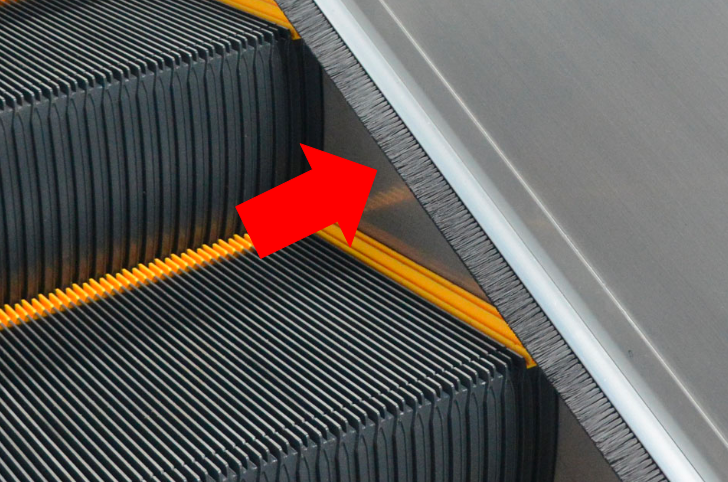Why Do Escalators Have Those Brushes Along the Edge?
The late comedian Mitch Hedberg once joked that “an escalator can never break; it can only become stairs.” (“There would never be an ‘Escalator Out of Order’ sign,” he’d continue, “only an ‘Escalator Temporarily Stairs, Sorry for the Convenience’” one.) And in practice, that’s often the case — escalators break often (sorry, Mitch), and as a result, many of us have walked up or down a stationary flight of escalator stairs while the motor is off.
And when we walk the stairs, we miss off on an opportunity to clean the sides of our shoes.
You know what I’m talking about — the little brushes on the sides of the escalator stairs! These guys:

Those are called… escalator brushes. Not the most creative name out there, but escalator engineers probably aren’t all that concerned with the branding of the various parts of their machines. What they are concerned about, though, is making sure your shoes remain free of dust, dirt, and debris.
No, not really. They’re concerned about safety. And those brushes? They trick us into being a bit safer.
Escalators break — and people break too — when we get too close to the edges. If you look at the picture above again, you’ll note that each stair has a yellow border around it; that’s supposed to be a warning to keep away from the sides. There’s a small gap (called the “skirt”) between the sides of the escalator and the maze of gears and motors beneath, and when things get into that gap, that’s when the escalator breaks (or temporarily becomes stairs). Even worse, when human body parts get into that little crevice, the machine often strong enough to cause real damage to the rider. For example, when California amended its escalator licensing laws to add some safety provisions, the legislature cited an incident in which “a four-year old boy [ . . .] lost three toes in an escalator entrapment incident.”
The brushes help prevent such accidents. As escalator supply company Schindler points out (pdf), “the surest way to avoid step-to-skirt accidents is to try to keep shoes, feet, and hands from getting near the gap in the first place.” The yellow borders (which aren’t universal) help a bit, as may the inclusion of a message to avoid the sides on a warning sign like this one. But those require a conscious effort to stay safe and let’s face it, most of us are thinking about other things than how to use an escalator safely. The brushes are there to trigger our subconscious into action. Otis Elevator’s product safety guide explains (pdf):
Passengers who stand too close to the skirt will feel the bristles and instinctively move away from the sides, making their ride safer. Because they make passengers aware of where they are standing, the brushes greatly reduce the probability of side-step entrapments or pinching. The brushes also tend to keep passengers’ clothing, luggage or other objects away from the skirt.
So if you aren’t paying attention, the brushes may save you from doing something dangerous without you even noticing. And please, don’t clean your shoes on the brushes — that totally defeats the purpose (and may be rather dangerous, too!).
Bonus fact: Elevators (there isn’t a ton of good escalator trivia out there, sorry) ding when they arrive on their floor, alerting those waiting that their ride has arrived. But listen carefully next time you’re waiting for an escalator, and you may notice that the number of dings tells a story. In the United States, at least, one ding means the elevator is going up, two means it’s on the way down. This is for ADA compliance; it helps the visually impaired determine if they’re going onto the right elevator.
From the Archives: Let’s Talk About Escalators: Not that we haven’t been already. But really, do we need them?
